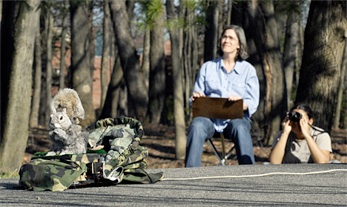Research Projects
in Partan Lab
Research Projects
in Partan Lab

Macaques: Field observations, video analysis, and video playbacks of facial expressions and vocalizations of rhesus monkeys. Macaques use a wide range of visual and audio signals to negotiate social interactions, and while the visual and vocal components can be redundant, in many cases they are not (see e.g. Partan 2002).

Pigeons: Video and audio playbacks of courtship in pigeons. Male pigeons bow and coo and circle while courting females. These are redundant signals of courtship that attract the female (Partan et al. 2005).
Elephants: Field observations and video analysis of visual communication in elephants. Elephants use a wide variety of subtle and not-so-subtle visual signals for social communication.
Lizards: "Robotic" playbacks of visual territorial signaling in Anolis lizards. We studied wild lizards in Florida to examine the significance of the variation in “pushup” displays between displaying males (Partan et al. 2011).
Here is a short video of a female responding to the mechanical lizard, who has just finished its display:
For publications, please click on “publications” above.
Page copyright S. Partan March 2011

Research area: Multimodal animal communication.
We study how animals communicate with audio and visual signals, focusing on the interactions among signal components from different sensory channels that are emitted simultaneously. Because animals communicate using all available channels, a complete understanding of their behavior must include examination of multiple signal channels. Our methods include field observation, video playbacks, and “robotic” animal playbacks with mechanical models.
Example Projects:
Squirrels: We are studying the function of visual and vocal signaling in Eastern gray squirrels. Gray squirrels are tree squirrels that give alarm calls when threatened. We present mechanical squirrel models in the field that are giving alarm displays, and record the responses of conspecifics to test whether or not the visual and audio components of the alarm signals are redundant. Our results suggest that the channels are redundant yet that they may be relied upon differently in different habitats (see Partan et al. 2009 and 2010 on the publication page of this web site).


AP photo (left).
New Work on Climate Change and Urbanization:
Climate change and urbanization are rapidly changing the environmental challenges faced by all animals, including ourselves. Work in our lab has begun to focus on whether and how animal signaling behavior changes to cope with rapid anthropogenic environmental change. See publications page for a 2013 article in BES with a special section on how animals may use multimodal signals to cope with rapid environmental change, and also a 2014 book chapter on urbanization and animal communication.